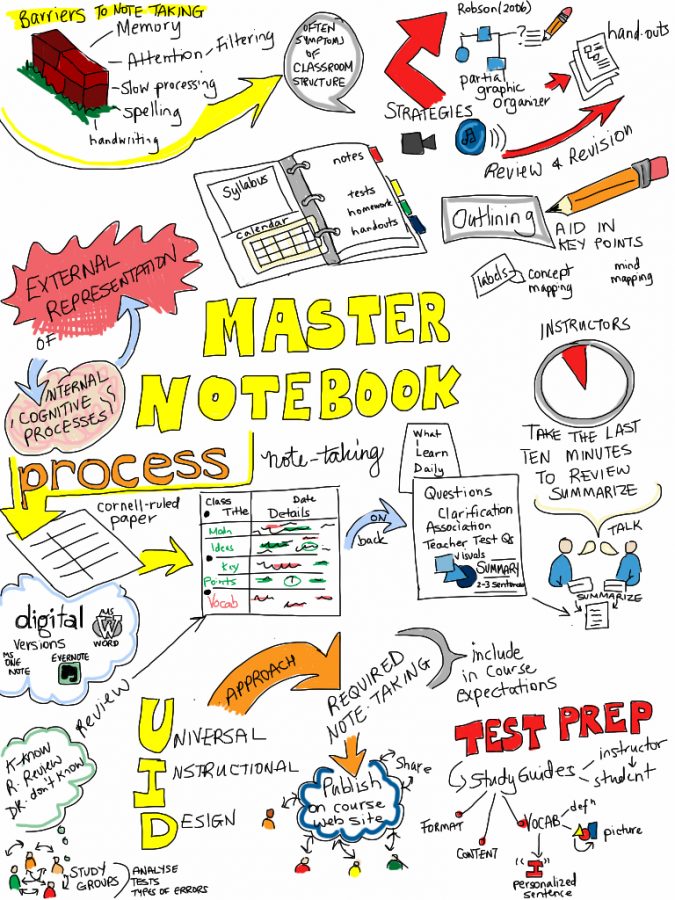Do You Take Notes Like This?
March 12, 2021
Imagine you are in class, and the teacher is speaking at high speed, going through slides as fast as you can see them. You are sitting there wondering how you will take notes and make sense of them. But then you have to consider the pro and cons of each technique. There’s typing, handwriting, and even doodling (yes, it can be as beneficial as the other two).
There has been a long-lasting debate throughout the decades about how to take notes. But what are notes? They are a brief record of facts or ideas that are supposed to help your memory. The benefits of notes in class are as many as stars in the sky. When we take notes actively during class, it helps us to focus and better understand the main concepts. Taking good notes can help us listen actively, comprehend the material, and retain it, both in the moment and later. It can help with synchronous and asynchronous learning. Good notes help us to reread and review the class material, sparing us time, energy, and confusion.
Should you be handwriting or typing? There are pros and cons to both. Typing your notes may be faster than writing them. That allows you to record more information from a lecture or discussion, for example, so that you can review later. It also improves readability, since some people have handwriting that is sloppy and difficult to read. When time has passed, the details of a discussion will become more difficult to remember, so typing really helps with that. It’s certainly an option. What, then, are the pros of handwriting? First, it is convenient because it doesn’t require charging. With laptops and iPads, that is a real concern. In one study, psychologists found that when we type notes, we take in all the information without filtering it. This seems like an advantage, but it is a disadvantage, too. When we write our notes, though, we can’t include everything. However, handwritten notes do enable students to process information on the spot because they have to decide what is or isn’t important. We can also learn to summarize, in a few words, the most relevant information, which helps to better understand the topic and make it memorable.
Basically, those who handwrite their notes know the topic better; that extra time spent writing is like another round of studying. Granted, some people handwrite slowly, making it difficult to keep up. Also, over time, the notes become harder to read. Thus, some students may prefer typing. Typing may not allow you to prioritize and condense the information as well, though, so it may not be preferable for those who can handwrite rather quickly. (Of course, if you know cursive, you may be able to write much faster than someone who uses block letters, but that could be the topic of a whole new article. . .)
Students don’t usually see doodling as a good technique for taking notes, but this is a misconception. For certain learners, doodling has its own advantages. Do you sit next to a classmate who doodles and wonder why the person is not taking notes? Well, there are doodle notes that increase engagement and increase learning and retention. Students who doodle may find it easier to focus. Their brains are ready for learning, their attention span increases, and doodling allows them to be attentive to detail, producing a “energized attitude.” They may experience increased concentration, greater retention, and lower stress. In effect, they are using problem-solving skills. While doodling has a number of benefits, one of them is that it uses both of the hemispheres of the brain. The right hemisphere deals with color, music, visuals, and creativity. The left hemisphere handles words, logic, numbers, reasoning, and writing. Doodlers can sometimes put vocabulary words, for example, into diagrams. Their color memory may form visual connections.
Whether you type your notes, write them, or even doodle, make sure that you are taking notes. The note-taking method may depend on the person, but you might consider different combinations. If you handwrite notes in class and then type them, it helps to organize the information in your mind, enhancing your cognitive impression. But if you can manage, doodling may be a better option. If you have an artistic flair and a way of bringing content and visuals together, this option is for you. It activates both the left and right hemispheres. It also encourages relaxation, memory, passion, focus, engagement, retention, and learning. All of that is a major plus.
